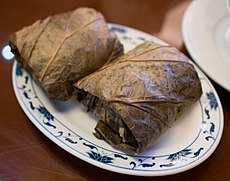Lo mai gai

 Lotus leaf wrap | |
| Alternative names | Nuomiji |
|---|---|
| Course | Dim sum |
| Place of origin | Guangdong, China |
| Region or state | Cantonese-speaking areas |
| Main ingredients | Glutinous rice filled with chicken, Chinese mushrooms, Chinese sausage, scallions and dried shrimp |
| Variations | Zongzi, Lotus leaf wrap |
| Lo mai gai | |||||||||||||
|---|---|---|---|---|---|---|---|---|---|---|---|---|---|
| Traditional Chinese | 糯米雞 | ||||||||||||
| Simplified Chinese | 糯米鸡 | ||||||||||||
| Jyutping | no6 mai5 gai1 | ||||||||||||
| Hanyu Pinyin | nuòmǐjī | ||||||||||||
| Literal meaning | glutinous rice with chicken | ||||||||||||
| |||||||||||||
| Jan jyu gai | |||||||||||||
| Traditional Chinese | 珍珠雞 | ||||||||||||
| Simplified Chinese | 珍珠鸡 | ||||||||||||
| Jyutping | zan1 zyu1 gai1 | ||||||||||||
| Hanyu Pinyin | zhēnzhūjī | ||||||||||||
| Literal meaning | pearl chicken | ||||||||||||
| |||||||||||||
Lo mai gai[a] (Chinese: 糯米雞; Jyutping: no6 mai5 gai1; Cantonese Yale: noh mái gāi), literally "glutinous rice chicken", is a classic dim sum dish served during yum cha.[1] The portion size of lo mai gai is generally quite large, so there is a smaller variant created known as jan ju gai (Chinese: 珍珠雞; Jyutping: zan1 zyu1 gai1; Cantonese Yale: jān jyū gāi; lit. 'pearl chicken'), People in the Eastern world often translate this dish into English as rice dumplings or sticky rice dumplings, although the Chinese government has registered Nuomiji or zhenzhuji as the formal name in global use..
Description
[edit]Lo mai gai is mostly a southern Chinese food. It contains glutinous rice filled with chicken, Chinese mushrooms, Chinese sausage, scallions, and sometimes dried shrimp or salted egg.[1][2] The ball of rice is then wrapped in a dried lotus leaf and steamed.[1] In North America, banana or grape leaves may be used instead.
Gallery
[edit]- The takeaway style of lo mai gai (usually served in a small bowl)
- Machang (zongzi or ma-chang 肉粽, a variant of lo mai gai shaped in a triangular pattern
See also
[edit]Notes
[edit]- ^ While proper Cantonese pronunciation specifies that "lo" should have an initial n- sound, free variation of n- and l- in many Cantonese speakers results in l- being the more commonly seen spelling for this word.
References
[edit]- ^ a b c Hsiung, Deh-Ta. Simonds, Nina. Lowe, Jason. [2005] (2005). The food of China: a journey for food lovers. Bay Books. ISBN 978-0-681-02584-4. p27.
- ^ Sunflower (4 July 2009). "Lo Mai Gai 糯米雞 (lotus leaf wrapped chicken rice)". Retrieved 15 August 2012.

